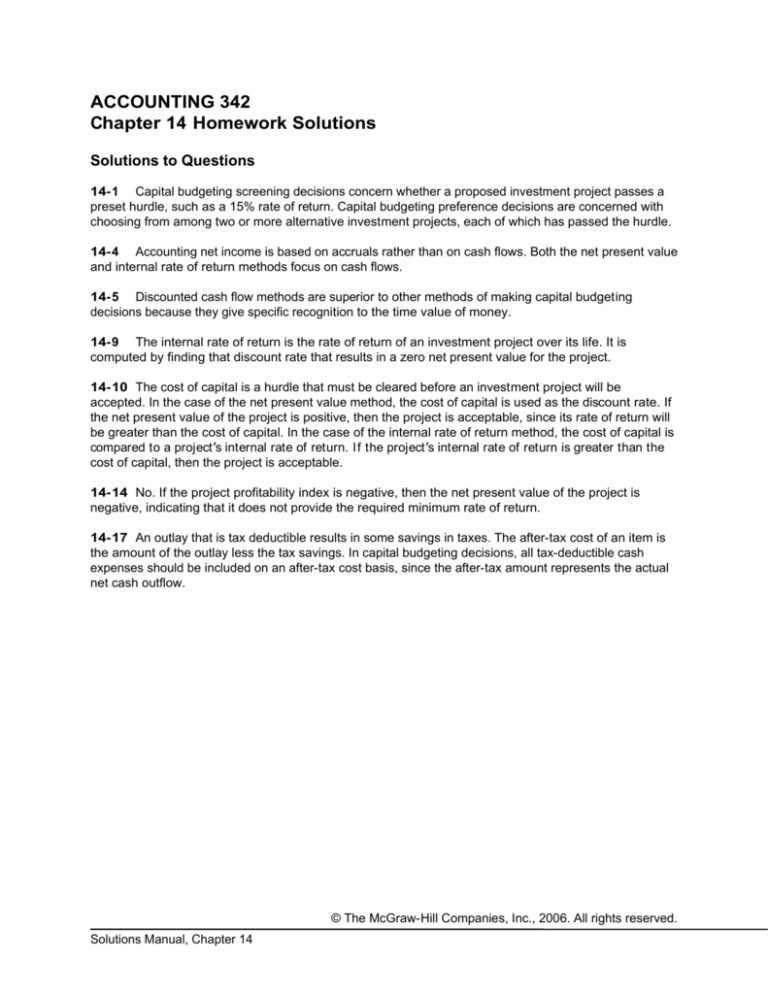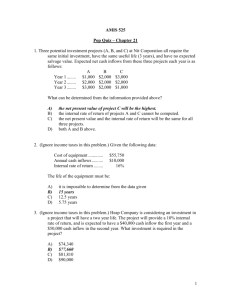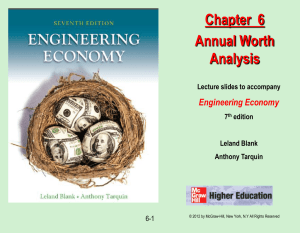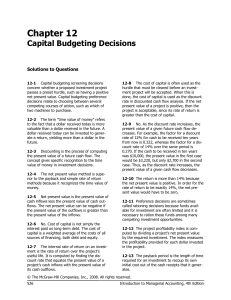
ACCOUNTING 342
Chapter 14 Homework Solutions
Solutions to Questions
14-1 Capital budgeting screening decisions concern whether a proposed investment project passes a
preset hurdle, such as a 15% rate of return. Capital budgeting preference decisions are concerned with
choosing from among two or more alternative investment projects, each of which has passed the hurdle.
14-4 Accounting net income is based on accruals rather than on cash flows. Both the net present value
and internal rate of return methods focus on cash flows.
14-5 Discounted cash flow methods are superior to other methods of making capital budgeting
decisions because they give specific recognition to the time value of money.
14-9 The internal rate of return is the rate of return of an investment project over its life. It is
computed by finding that discount rate that results in a zero net present value for the project.
14-10 The cost of capital is a hurdle that must be cleared before an investment project will be
accepted. In the case of the net present value method, the cost of capital is used as the discount rate. If
the net present value of the project is positive, then the project is acceptable, since its rate of return will
be greater than the cost of capital. In the case of the internal rate of return method, the cost of capital is
compared to a project s internal rate of return. If the project s internal rate of return is greater than the
cost of capital, then the project is acceptable.
14-14 No. If the project profitability index is negative, then the net present value of the project is
negative, indicating that it does not provide the required minimum rate of return.
14-17 An outlay that is tax deductible results in some savings in taxes. The after-tax cost of an item is
the amount of the outlay less the tax savings. In capital budgeting decisions, all tax-deductible cash
expenses should be included on an after-tax cost basis, since the after-tax amount represents the actual
net cash outflow.
© The McGraw-Hill Companies, Inc., 2006. All rights reserved.
Solutions Manual, Chapter 14
Exercise 14- 1
1.
Cash
Item
Year(s)
Flow
Annual cost savings...
1-8
$7,000
Initial investment ...... Now $(40,000)
Net present value......
12%
Factor
4.968
1.000
Present
Value of
Cash
Flows
$ 34,776
(40,000)
$ (5,224)
2.
Cash
Flow
Item
Years
Annual cost savings... $7,000
8
Initial investment ...... $(40,000)
1
Net cash flow............
Total
Cash
Flows
$ 56,000
(40,000)
$ 16,000
© The McGraw-Hill Companies, Inc., 2006. All rights reserved.
Solutions Manual, Chapter 14
Exercise 14- 3
1. Note: All present value factors in the computation below have been
taken from Table 14C-3 in Appendix 14C, using a 12% discount rate.
Amount of the investment............................
$104,950
Less present value of Year 1 and Year 2
cash inflows:
Year 1: $30,000 × 0.893 ........................... $26,790
Year 2: $40,000 × 0.797 ........................... 31,880
58,670
Present value of Year 3 cash inflow...............
$ 46,280
Therefore, the expected cash inflow for Year 3 would be:
$46,280 ÷ 0.712 = $65,000.
2. The equipment s net present value without considering the intangible
benefits would be:
Item
Year(s)
Cost of the equipment .. Now
Annual cost savings ...... 1-15
Net present value.........
Amount of
20% Present Value
Cash Flows Factor of Cash Flows
$(2,500,000) 1.000 $(2,500,000)
$400,000 4.675
1,870,000
$ (630,000)
The annual value of the intangible benefits would have to be great
enough to offset a $630,000 negative present value for the equipment.
This annual value can be computed as follows:
Required increase in present value
$630,000
=
= $134,759
Factor for 15 years
4.675
3. Factor of the internal Investment in the project
=
rate of return
Annual cash inflow
=
$106,700
= 5.335
$20,000
Looking in Table 14C-4, and scanning down the 10% column, we find
that a factor of 5.335 equals 8 periods. Thus, the equipment will have to
be used for 8 years in order to yield a return of 10%.
© The McGraw-Hill Companies, Inc., 2006. All rights reserved.
Solutions Manual, Chapter 14
Exercise 14- 17
(1)
Amount
(1) × (2)
After-Tax
(2)
Tax Effect Cash Flows
Items and Computations
Year(s)
Project A:
Investment in heavy trucks ........ Now $(130,000)
Net annual cash inflows............. 1-9
$25,000 1 0.30
Depreciation deductions*........... 1-5
$26,000
0.30
Salvage value of the trucks ........
9
$15,000 1 0.30
Net present value......................
Project B:
Investment in working capital ....
Net annual cash inflows.............
Release of working capital .........
Net present value......................
Now
1-9
9
$(130,000)
$25,000 1
$130,000
0.30
12%
Factor
Present
Value of
Cash Flows
$(130,000)
$17,500
$7,800
$10,500
1.000
5.328
3.605
0.361
$(130,000)
93,240
28,119
3,791
$ (4,850)
$(130,000)
$17,500
$130,000
1.000
5.328
0.361
$(130,000)
93,240
46,930
$ 10,170
*$130,000 ÷ 5 years = $26,000 per year
© The McGraw-Hill Companies, Inc., 2006. All rights reserved.
Solutions Manual, Chapter 14
4
Exercise 14- 18
1.
Annual cost of operating the present equipment .......
Annual cost of the new dishwashing machine:
Cost for wages of operators ..................................
Cost for maintenance ...........................................
Net annual cost savings (cash inflow) ......................
$85,000
$48,000
2,000
50,000
$35,000
2. The net present value analysis would be as follows:
(1) × (2)
After-Tax
(1)
(2)
Cash
Items and Computations
Year(s) Amount Tax Effect
Flows
Cost of the new dishwashing machine . Now $(140,000)
$(140,000)
Net annual cost savings (above) ......... 1-12
$35,000 1 0.30
$24,500
Depreciation deductions* ................... 1-7
$20,000
0.30
$6,000
Cost of the new water jets .................
6
$(15,000) 1 0.30
$(10,500)
Salvage value of the new machine ......
12
$9,000 1 0.30
$6,300
Net present value ..............................
14%
Factor
1.000
5.660
4.288
0.456
0.208
Present
Value of
Cash
Flows
$(140,000)
138,670
25,728
(4,788)
1,310
$ 20,920
*$140,000 ÷ 7 years = $20,000 per year
Yes, the new dishwashing machine should be purchased.
© The McGraw-Hill Companies, Inc., 2006. All rights reserved.
Solutions Manual, Chapter 14
5
Problem 14- 19
Amount of
20%
Item
Year(s) Cash Flows Factor
Cost of new equipment ............ Now R(275,000) 1.000
Working capital required .......... Now R(100,000) 1.000
Net annual cash receipts .......... 1-4
R120,000 2.589
Cost to construct new roads .....
3
R(40,000) 0.579
Salvage value of equipment......
4
R65,000 0.482
Working capital released ..........
4
R100,000 0.482
Net present value ....................
Present
Value of
Cash Flows
R(275,000)
(100,000)
310,680
(23,160)
31,330
48,200
R (7,950)
No, the project should not be accepted; it has a negative net present value
at a 20% discount rate. This means that the rate of return on the
investment is less than the company s required rate of return of 20%.
© The McGraw-Hill Companies, Inc., 2006
Solutions Manual, Chapter 14
6
Problem 14-20
1. The net annual cost savings would be:
Reduction in labor costs ........................................... $108,000
Reduction in material waste .....................................
6,500
Total....................................................................... 114,500
Less increased maintenance costs ($3,000 × 12) .......
36,000
Net annual cost savings ........................................... $ 78,500
2. Using this cost savings figure, and other data from the text, the net
present value analysis would be:
Amount of
Item
Year(s) Cash Flows
Cost of the machine.............. Now
$(500,000)
Software and installation....... Now
$(80,000)
Salvage of the old
equipment......................... Now
$12,000
Annual cost savings (above) .. 1-12
$78,500
Replacement of parts............
7
$(45,000)
Salvage of the new machine..
12
$20,000
Net present value .................
Present
16%
Value of
Factor Cash Flows
1.000 $(500,000)
1.000
(80,000)
1.000
5.197
0.354
0.168
12,000
407,965
(15,930)
3,360
$(172,605)
No, the automated welding machine should not be purchased. It has a
negative net present value at a 16% discount rate.
3. The dollar value per year that would be required for the intangible
benefits would be:
Negative net present value to be offset
$172,605
=
= $33,212
Present value factor
5.197
Thus, the automated welding machine should be purchased if
management believes that the intangible benefits are worth at least
$33,212 per year.
© The McGraw-Hill Companies, Inc., 2006
Solutions Manual, Chapter 14
7
Problem 14-22
1. The income statement would be:
Sales revenue ...........................................
Less variable expenses:
Cost of ingredients (20% × $300,000)...... $60,000
Commissions (12.5% × $300,000) ........... 37,500
Contribution margin...................................
Less operating expenses:
Salaries .................................................. $70,000
Rent ($3,500 × 12) ................................. 42,000
Depreciation* ......................................... 16,800
Insurance...............................................
3,500
Utilities .................................................. 27,000
Net operating income ................................
$300,000
97,500
202,500
159,300
$ 43,200
* $270,000 $18,000 = $252,000
$252,000 ÷ 15 years = $16,800 per year.
2. The formula for the simple rate of return is:
Simple rate of return =
=
Annual incremental net operating income
Initial investment
$43,200
= 16.0%
$270,000
Yes, the franchise would be acquired since it promises a rate of return in
excess of 12%.
© The McGraw-Hill Companies, Inc., 2006
Solutions Manual, Chapter 14
8
Problem 14-22 (continued)
3. The formula for the payback period is:
Payback period =
Investment required
Net annual cash inflow
=
$270,000
= 4.5 years
$60,000*
*$43,200 Net operating income + $16,800 Depreciation =
$60,000 Net annual cash inflow
According to the payback computation, the franchise would not be
acquired. The 4.5 years payback is greater than the maximum 4 years
allowed. Payback and simple rate of return can give conflicting signals
as in this example.
© The McGraw-Hill Companies, Inc., 2006
Solutions Manual, Chapter 14
9
Problem 14- 23
(1)
Items and Computations
Year(s) Amount
Investment in the new trucks ........... Now $(350,000)
Salvage from sale of the old trucks ... Now
$16,000
Net annual cash receipts ..................
1-7
$105,000
Depreciation deductions* .................
1-5
$70,000
Replacement of motors ....................
4
$(45,000)
Salvage from the new trucks ............
7
$18,000
Net present value ............................
(2)
Tax Effect
1
1
0.30
0.30
0.30
1 0.30
1 0.30
(1) × (2)
Present
After-Tax
Value of
Cash
16%
Cash
Factor
Flows
Flows
$(350,000) 1.000 $(350,000)
$11,200 1.000
11,200
$73,500 4.039
296,867
$21,000 3.274
68,754
$(31,500) 0.552
(17,388)
$12,600 0.354
4,460
$ 13,893
*$350,000 ÷ 5 years = $70,000 per year
Since the project has a positive net present value, the contract should be accepted
© The McGraw-Hill Companies, Inc., 2006
Solutions Manual, Chapter 14
10
Problem 14-24
1. The net annual cash inflows would be:
Reduction in annual operating costs:
Operating costs, present hand method ................. $30,000
Operating costs, new machine .............................
7,000
Annual savings in operating costs......................... 23,000
Increased annual contribution margin:
6,000 boxes × $1.50 per box ...............................
9,000
Total net annual cash inflows.................................. $32,000
2.
Present
Amount of 20%
Value of
Item
Year(s) Cash Flows Factor Cash Flows
Cost of the machine ........... Now
$(120,000) 1.000 $(120,000)
Replacement of parts..........
6
$(9,000) 0.335
(3,015)
Annual cash inflows
(above)........................... 1-12
$32,000
4.439
142,048
Salvage value of the
machine.......................... 12
$7,500
0.112
840
Net present value ...............
$ 19,873
© The McGraw-Hill Companies, Inc., 2006
Solutions Manual, Chapter 14
11
Problem 14-26
1. Factor of the internal
Investment required
=
rate of return
Net annual cash inflow
=
$330,000
= 4.125
$80,000
From Table 14C-4, reading along the 9-period line, a factor of 4.125 is
closest to 19%.
2. Factor of the internal
Investment required
=
rate of return
Net annual cash inflow
We know the investment is $330,000, and we can determine the factor
for an internal rate of return of 14% by looking in Table 14C-4 along the
9-period line. This factor is 4.946. Using these figures in the formula, we
get:
$330,000
= 4.946
Net annual cash inflow
Therefore, the annual cash inflow would be: $330,000 ÷ 4.946 =
$66,721.
3. a. 6-year useful life:
The factor for the internal rate of return would still be 4.125 [as
computed in (1) above]. From Table 14C-4, reading along the 6period line, a factor of 4.125 falls closest to 12%.
b. 12-year useful life:
The factor of the internal rate of return would again be 4.125. From
Table 14C-4, reading along the 12-period line, a factor of 4.125 falls
closest to 22%.
© The McGraw-Hill Companies, Inc., 2006
Solutions Manual, Chapter 14
12
Problem 14-26 (continued)
The 12% return in part (a) is less than the 14% minimum return that
Ms. Winder wants to earn on the project. Of equal or even greater
importance, the following diagram should be pointed out to Ms. Winder:
6
Years
12%
3 years shorter
A decrease
of 7%
9
Years
19%
3 years longer
12
Years
22%
An increase of
3%
As this illustration shows, a decrease in years has a much greater impact
on the rate of return than an increase in years. This is because of the
time value of money; added cash inflows far into the future do little to
enhance the rate of return, but loss of cash inflows in the near term can
do much to reduce it. Therefore, Ms. Winder should be very concerned
about any potential decrease in the life of the equipment, while at the
same time realizing that any increase in the life of the equipment will do
little to enhance her rate of return.
© The McGraw-Hill Companies, Inc., 2006
Solutions Manual, Chapter 14
13
Problem 14- 26 (continued)
4. a. The expected annual cash inflow would be:
$80,000 × 80% = $64,000.
$330,000
= 5.156 (rounded)
$64,000
From Table 14C-4, reading along the 9-period line, a factor of 5.156 is
closest to 13%.
b. The expected annual cash inflow would be:
$80,000 × 120% = $96,000.
$330,000
= 3.438 (rounded)
$96,000
From Table 14C-4, reading along the 9-period line, a factor of 3.438 is
closest to 25%.
Unlike changes in time, increases and decreases in cash flows at a given
point in time have basically the same impact on the rate of return, as
shown below:
20% decrease
$64,000
Cash Inflow
13%
A decrease
of 6%
$80,000
Cash Inflow
19%
20% increase
$96,000
Cash Inflow
25%
An increase
of 6%
© The McGraw-Hill Companies, Inc., 2006
Solutions Manual, Chapter 14
14
Problem 14- 26 (continued)
5. Since the cash flows are not even over the 8-year period (there is an
extra $135,440 cash inflow from sale of the equipment at the end of the
eighth year), some other method has to be used to compute the internal
rate of return. Using trial-and-error or more sophisticated methods, it
turns out that the internal rate of return is 10%. This can be verified by
computing the net present value of the project, which is zero at the
discount rate of 10%, as shown below:
Amount of 10%
Item
Year(s) Cash Flows Factor
Investment in the equipment . Now
$(330,000) 1.000
Annual cash inflow ................ 1-8
$50,000 5.335
Sale of the equipment ...........
8
$135,440 0.467
Net present value................................
Present
Value of
Cash Flows
$(330,000)
266,750
63,250
$
0
© The McGraw-Hill Companies, Inc., 2006
Solutions Manual, Chapter 14
15
Problem 14- 29
1. The annual incremental net operating income can be determined as
follows:
Ticket revenue (50,000 × $3.60) ....
Less operating expenses:
Salaries ......................................
Insurance...................................
Utilities ......................................
Depreciation* .............................
Maintenance...............................
Total operating expenses ...............
Net operating income ....................
$180,000
$85,000
4,200
13,000
27,500
9,800
139,500
$ 40,500
*$330,000 ÷ 12 years = $27,500 per year.
2. The simple rate of return would be:
Annual incremental net operating income
Simple rate =
of return
Initial investment (net of salvage from old equipment)
=
$40,500
$40,500
=
= 15%
$330,000 - $60,000
$270,000
Yes, the water slide would be constructed. Its return is greater than the
specified hurdle rate of 14%.
3. The payback period would be:
Payback = Investment required (net of salvage from old equipment)
period
Net annual cash inflow
=
$330,000 - $60,000
$270,000
=
= 3.97 years (rounded)
$68,000*
$68,000*
*Net operating income + depreciation = $40,500 + $27,500 =
$68,000.
Yes, the water slide would be constructed. The payback period is within
the maximum 5 years required by Mr. Sharkey.
© The McGraw-Hill Companies, Inc., 2006
Solutions Manual, Chapter 14
16
Problem 14- 33
(1)
Amount
(2)
Tax
Effect
Items and Computations
Year(s)
Alternative 1:
Investment in the bonds................ Now $(225,000)
Interest on the bonds
(10% × $225,000) ..................... 1-12
$22,500 1
Maturity of the bonds ....................
12
$225,000
Net present value..........................
(1) × (2)
After-Tax
Cash
8%
Factor
Flows
Present
Value of
Cash
Flows
$(225,000) 1.000 $(225,000)
0.40
$13,500
$225,000
7.536
0.397
101,736
89,325
$ (33,939)
© The McGraw-Hill Companies, Inc., 2006
Solutions Manual, Chapter 14
17
Problem 14- 33 (continued)
(1)
Amount
(2)
Tax
Effect
(1) × (2)
After-Tax
Cash
8%
Factor
Flows
Present
Value of
Cash
Flows
Items and Computations
Year(s)
Alternative 2:
Investment in the business ..................... Now $(225,000)
$(225,000) 1.000 $(225,000)
Net annual cash receipts
($850,000 $780,000 = $70,000)........... 1-12
$70,000 1 0.40 $42,000 7.536 316,512
Depreciation deductions:
Year 1: 14.3% of $80,000 ....................
1
$11,440 0.40
$4,576 0.926
4,237
Year 2: 24.5% of $80,000 ....................
2
$19,600 0.40
$7,840 0.857
6,719
Year 3: 17.5% of $80,000 ....................
3
$14,000 0.40
$5,600 0.794
4,446
Year 4: 12.5% of $80,000 ....................
4
$10,000 0.40
$4,000 0.735
2,940
Year 5: 8.9% of $80,000 ....................
5
$7,120 0.40
$2,848 0.681
1,939
Year 6: 8.9% of $80,000 ....................
6
$7,120 0.40
$2,848 0.630
1,794
Year 7: 8.9% of $80,000 ....................
7
$7,120 0.40
$2,848 0.583
1,660
Year 8: 4.5% of $80,000 ....................
8
$3,600 0.40
$1,440 0.540
778
Payment to break the lease ....................... 12
$(2,000) 1 0.40
$(1,200) 0.397
(476)
Recovery of working capital
($225,000 $80,000 = $145,000)............
12
$145,000
$145,000 0.397
57,565
Net present value .......................................
$173,114
Net present value in favor of alternative 2 ..
$207.053
© The McGraw-Hill Companies, Inc., 2006
Solutions Manual, Chapter 14
18








